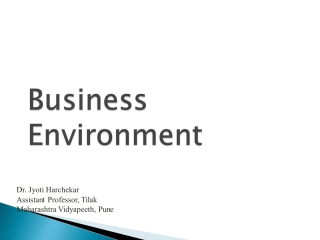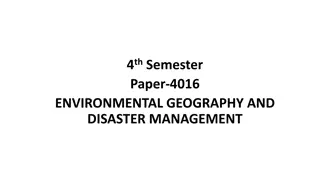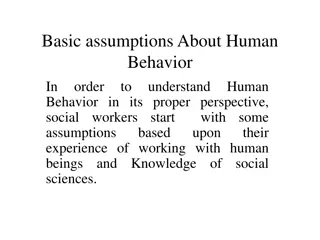An Introduction to Human Factors
Gain a comprehensive understanding of Human Factors, the multidisciplinary field that focuses on optimizing human performance and creating safer working environments. Explore the various factors that influence human behavior and learn how to apply this knowledge to improve safety, decision-making, communication, and more.
- Human Factors
- Safety
- Performance
- Behavior
- Optimization
- Decision-making
- Communication
- Multidisciplinary
Download Presentation

Please find below an Image/Link to download the presentation.
The content on the website is provided AS IS for your information and personal use only. It may not be sold, licensed, or shared on other websites without obtaining consent from the author. Download presentation by click this link. If you encounter any issues during the download, it is possible that the publisher has removed the file from their server.
E N D
Presentation Transcript
An Introduction to Human Factors Compiled by the Human Factors Programme Team Feb 2022
What is Human Factors? There are many definitions of Human Factors, such as: "Human factors refer to environmental, organisational and job factors, and human and individual characteristics, which influence behaviour at work in a way which can affect health and safety" -HSE Human factors is multidisciplinary effort to generate and compile information about human capabilities and limitations and apply that information to equipment, systems, facilities, procedures, jobs, environments, training, staffing, and personnel management for safe, comfortable, and effective human performance FAA One of the objectives is making it easier for being to do the right thing, difficult to do the wrong thing and almost impossible to do the catastrophic thing - ICAO Understanding people Understanding Organisations Reviewing incidents Leadership Learning Optimising Human Performance
What is Human Factors? We are all human - yet different people have differing knowledge, skills, experience, attitudes, and abilities. We can all be influenced by our environment and the people around us, some get tired, some get distracted and some people think they can crack on and get the job done! Human Factors (HF) has been studied for a long time, the more we learn about humans and the performance influencing factors (PIFS) that shape us, the safer the working environment can be. HF spans across a wide range of different and diverse industries such as; aviation, rail, healthcare and chemical engineering. The study of Human Factors looks at: The human The job The working environment The organisation Human Factors is about getting the best out of humans and making the workplace a safer place for everyone.
What does Human Factors involve? Average behaviours Decision making Communication Linguistics Automation Understanding Stress Crew Resource Management Error Cognitive engineering Skills Workload Situation awareness Cognitive psychology Work psychology Education psychology Cultural issues Spatial disorientation Fatigue Human Machine Interaction Medicine Teaching techniques Anthropometrics Social psychology Perception Cosmic effects Physiology Smells Health & safety Conditioning Ergonomics Sociology Neuro psychology Social Individual collective biological Psychiatric Psycho pathology Clinical psychology Counselling Psychology Pathological behaviours
The Performance zone The performance zone is a great tool when visualising all the things around us that affect our behaviour, they can both effect us in good and bad ways. Here is Sam, they come to work everyday and perform to the best of their ability, yet they are surrounded by performance influencing factors (PIFS). Just look at all the things around Sam that may influence their performance! Organisational the PIFs that are introduced by the organisation. Complacency Noise Training Fatigue Managers Personal the PIFs that we build throughout our lives at work and at home. We cannot leave these PIFS at home and they may affect us at work. Team mates Mobility Complex systems Equipment Vision Temperature Stress It is important to remember that we may not be able to fix some of the PIFS around Sam, sometimes just acknowledging them can help. Past experiences Communication Time pressures Alcohol/Drugs Lighting Situational Awareness Distractions Human Factors is about getting the best out of humans and making the workplace a safer place for everyone.
ICAO 5 Principles of Human Performance The International Civil Aviation Organisation has highlighted five key aspects of Human Performance 1: People s performance is shaped by their capabilities and limitations Human Performance 2: People perform in ways that make sense to them 5: People s performance is influenced by interactions with other people 3: People adapt to the demands of a complex and dynamic work environment 4: People assess risk and make trade- offs all the time
Why is Human Factors important? Due to the risks associated with building, maintaining, supporting and operating within the aviation system, it is vital we understand how Human Factors (HF) can affect the people involved in the system at all levels. To reduce the HF risk, we must influence attitudes and behaviours across the industry and apply a HF approach and Systems Thinking into our work. By taking this approach, we aim to improve aviation safety and keep the interests of the consumer at the heart of our work.
Useful Links https://ergonomics.org.uk/ https://www.icao.int/safety/OPS/OPS-Normal/Pages/HP.aspx https://www.hf.faa.gov/ https://sma.nasa.gov/sma-disciplines/human-factors https://www.aerosociety.com/get-involved/specialist-groups/safety/human-factors/ https://www.hse.gov.uk/humanfactors/introduction.htm

















































